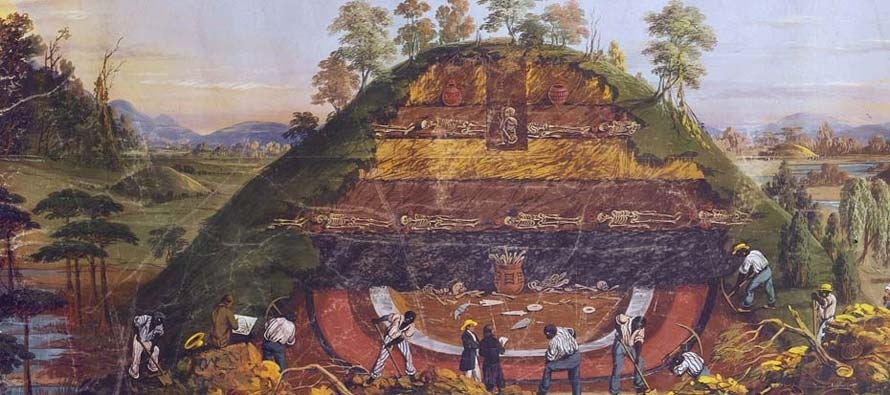In England and in the US barrows and mounds look like earth-covered food bowls. Sun 02 January 2022

Bodies layered in a native American mound above a bowl-shaped barrow. Source
Do we find any more support for the claim 'many 'prehistoric' mounds started out as food bowls'?
Yes.
From Forty years' researches in British and Saxon burial mounds of East Yorkshire, John Robert Mortimer, 1905, Introduction, page xxiv:
The fact that broken and dismembered human bones - often associated with animal bones - mixed in the grave and in the mound, have been found in so many of the barrows I have opened, would seem to indicate that they had often served the same purpose as did the animal bones. These scattered human bones, like the associated animal bones, are generally in far better preservation than those of the internment below. They have also a different appearance, as if they had been somewhat changed, probably by some process of cooking. Repulsive as cannibalism is, the evidence of its existence in the barrows of this neighbourhood seems to me so strong as to place its former practice beyond doubt.
And from Welcome to Merton, Norfolk:
...to the right of Pedders Way an old Roman pavement, 10 yds square, was discovered about 3ft below the surface; and again bordering on the way in the Park, in trenching for a plantation, there were found bones of sheep and oxen, horns of deer, much broken Roman pottery, coin's and a knife blade, also a human skeleton without a head.
The skeleton without a head is a mystery, the park is of a locality where ghosts and goblins, black and white witches,and such like, were very dear to the native heart.
A decapitated human skeleton... found with 'Roman' cookware and knife... next to a road... in an area associated with goblins. This should not be a mystery to us: headlessness is a primary indicator of butchery and cookware is a primary indicator of cooking.
Folklore agrees with archaeology. In The Quest for Tom Hickathrift - Legends in the Landscape, Mike Burgess describes the bowls associated with Norfolk giant Tom Hickathrift. Next to Hickathrift's grave - apparently at: (Google Maps), (Google Streetview), (OpenStreetMap), (NLS), (Flickr images)) - were two depressions. One called Hickathrift's Hand Basin, the other Hickathrift's Feeding Bowl.
Sounds like Tom was a big eater.
Two of many butchery locations in west Norfolk
The need to hide routine butchery may explain why archaeologists only find remains of sacrifices and wars.
Similarly, a desire to hide artisanal chemistry may explain why archaeologists only find public baths and not vats; temples instead of workshops; altars and shrines instead of worktops, hillforts instead of remains of mineral-processing works.
© All rights reserved. The original author retains ownership and rights.
More of this investigation:
Fingerprints of the Clean Up Team,
More of this investigation:
The Reformation was a Reformatting
More by tag:
#mounds, #giants